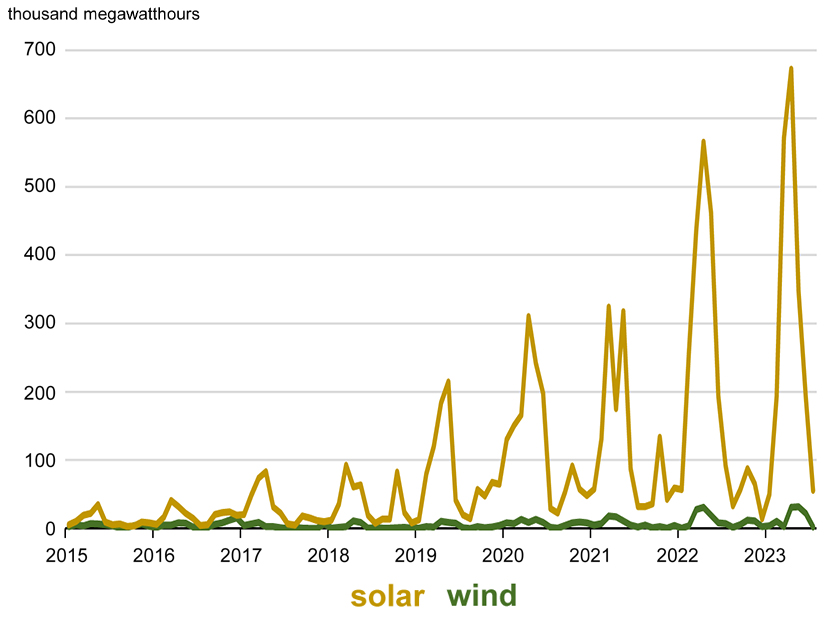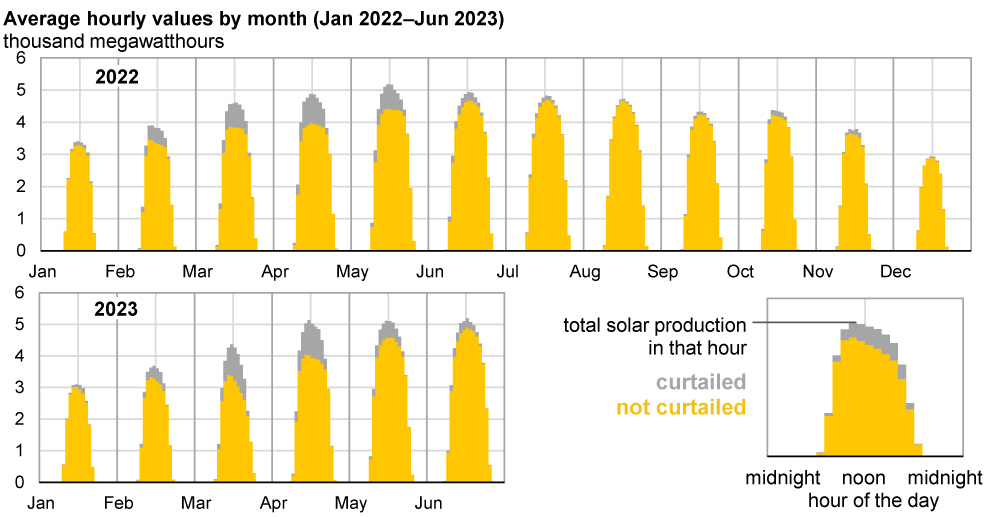
CAISO’s curtailment of solar and wind power is on the rise, and about three-quarters of curtailments so far this year have been from transmission congestion.
CAISO’s curtailment of solar and wind power in California is on the rise, and about three-quarters of curtailments so far this year have been from transmission congestion.
The remainder of curtailments in the first nine months of 2023 were due to oversupply, according to an analysis of CAISO data by the U.S. Energy Information Administration (EIA).
“Congestion-related curtailments have increased significantly since 2019 because solar generation has been outpacing upgrades in transmission capacity,” EIA said in its report.
CAISO’s solar and wind curtailments have been increasing since at least 2015, EIA found. Solar made up roughly 95% of the curtailments and wind accounted for the rest.
In 2022, CAISO’s curtailment of utility-scale solar and wind was 2.4 million MWh, a 63% increase compared with 2021.
On a month-to-month basis, solar curtailment peaked in April 2023 at 702,883 MWh. That compares to the previous peak of 596,175 MWh in April 2022.
CAISO said on its website that it expects to see oversupply conditions more frequently as amounts of renewable resources grow. The ISO is pursuing several strategies to address the issue.
“Key to curtailment reductions are the interconnection process enhancements, the 2022/23 transmission planning process and increasing amounts of battery storage,” CAISO spokesperson Anne Gonzales told RTO Insider.
California now has more than 6,600 MW of battery energy storage systems online, up from 770 MW in 2019, the California Energy Commission reported last week.
CAISO has also pointed to expansion of its Western Energy Imbalance Market (WEIM) as a way to reduce renewable energy oversupply and curtailment. The WEIM allows surplus energy to be shared across the region rather than reducing output.
According to EIA, trading within the WEIM prevented more than 10% of total possible curtailments in 2022.
As for CAISO’s upcoming Extended Day-Ahead Market (EDAM), Gonzales said the impact on curtailment would depend on the participation footprint. She noted that energy curtailments occur in real time, while EDAM is a day-ahead market.
A state-led study last year found “incremental curtailment reductions” in a West-wide EDAM scenario, Gonzales said.
CAISO has pointed to other strategies that may reduce curtailment, including time-of-use rates and EV charging systems that respond to grid conditions. In addition, policies could be explored to reduce existing generators’ minimum operating levels, making room for more renewable production.
Storage, Transmission Planning
When asked about EIA curtailment analysis, Jan Smutny-Jones, CEO of the Independent Energy Producers Association, said most solar developers are building solar-plus-storage projects to capture the benefits of meeting net peak demand.
“In addition, Western regionalization would provide a broader market for excess solar in other states,” Smutny-Jones told RTO Insider.
Mark Specht, Western states energy manager for the Union of Concerned Scientists, said the fact that most of the solar curtailment in California is due to congestion indicates that solar energy is getting “trapped” in certain locations without sufficient transmission to send it elsewhere.
A key strategy for solving the problem is coordinated transmission planning across the West, he said.
Battery storage is another possible way to reduce curtailment, said Specht, who recommended adding batteries to existing solar projects that lack storage.
Still, Specht said, building all the infrastructure needed to capture every drop of solar energy probably doesn’t make economic sense, and “some amount of curtailment is okay.”
“Zero curtailment shouldn’t necessarily be the goal,” Specht said.



